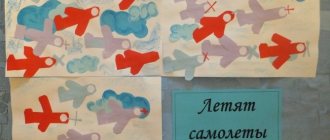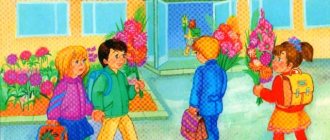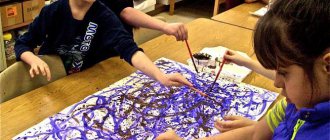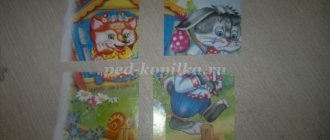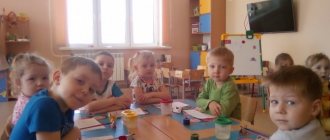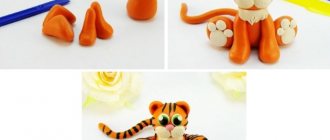Preview:
— teach children to convey the image of a flower using the poking method;
- place the image across the entire sheet;
— consolidate knowledge of colors (yellow, green);
- develop children's creative imagination;
- evoke an emotional and aesthetic response to the topic of the lesson;
- cultivate a caring attitude towards nature.
Demonstration material: sample drawing, painting of a dandelion in the grass, bell
Handouts: brushes for each child, napkins, yellow and green gouache, 0.5 album sheet, butterflies.
Q: The bell rings and gathers everyone in a circle.
Q: Guys, it’s a wonderful time of year. Who knows which one?
Spring has come to us again,
How much light and warmth!
The snow is melting, the streams are babbling,
Sparrows are jumping in the puddles!
All nature is waking up from a long sleep. And besides this, what else is happening? (Also, flowers will bloom soon.)
Abstract of the educational activity “Flowers in the Meadow”
Summary of direct educational activities
in the educational field “Artistic and aesthetic development” (productive activity - drawing) “Flowers in the meadow” (for young children 2-3 years old)
using non-traditional painting technologies – painting with potato blocks
Prepared by the teacher
Kuzmina Oksana Anatolyevna
Saint Petersburg
Target:
develop the ability to convey in a drawing the image of a flower, the beauty of a blooming meadow, using figured potato bars.
Educational tasks:
cultivate interest in artistic creativity and organization.
Developmental tasks:
develop the ability to think logically, justify your answers, develop speech, fantasy, imagination, fine motor skills.
Educational objectives
: introduce young children to an unconventional drawing technique - drawing with a potato block, using different colors; clarify and consolidate knowledge of color; enrich speech with new nouns - names of meadow flowers; develop imagination, color perception; cultivate a love of nature, promote the ability to enjoy your drawing.
Main educational area:
artistic and aesthetic development.
Integrated educational areas:
speech development, cognitive development, physical development.
Methods and techniques:
Methods:
gaming, practical.
Techniques:
goal setting, riddles, unconventional drawing techniques - drawing with a potato block, practical help, encouragement.
Didactic material:
Demo material:
Masha doll, basket, flat images of wildflowers for flannelgraph, details of the game “Collect a flower” for flannelgraph (stem, leaves, core, petals).
Handout:
landscape tinted sheets of green, rosettes with gouache in yellow, blue, red, napkins, potato bars cut in the shape of a dandelion, cornflower, poppy on a plate.
Preliminary work:
learning finger gymnastics “Our hands are like flowers”, looking at illustrations and plot pictures on this topic, talking about flowers, riddles about flowers.
Progress:
- Guys, we have a guest today. Let's say hello to her. Who is this? (doll)
- Look, the Masha doll has come to us
She brought different flowers in a basket.
And yellow, red, blue
That's how beautiful they all are.
-Let's see what they are called (the teacher takes out a flower one by one, reads a poem, asks the children about it, attaches it to the flannelgraph):
1. Sun drops early in the morning
Appeared in the clearing
This is in a yellow sundress
Preview:
Summary of the drawing lesson “Blooming Meadow”.
— Reinforce the techniques of drawing with a brush, pencil, and crayons.
— Learn to come up with the location of the plot on the sheet.
— Learn to draw a preliminary outline of a drawing using a simple pencil.
— Develop creative imagination in children.
2. Conduct vocabulary work on the following topics:
- Objects (meadow, grass, flowers, bell, mouse pea, clover, chamomile, clove).
— Signs of objects (bright, colorful, endless, blooming, charming, gentle, modest, shy).
- Actions (bloom, variegate, sparkle, caress, turn green, blossom, bloom).
1. Examination of the illustrations “Blooming Meadow” and carrying out vocabulary work
2. Execution of work.
3. Children's story about their work.
Lesson summary on the application “Chamomile Lawn”
— Teach symmetrical cutting from a folded (“2 times”) square; cutting
leaves with a serrated edge.
- Encourage imagination and independence.
2. Vocabulary work:
— Explain the expression “Flowers nod their heads.”
- Form a sign from an object (chamomile - chamomile meadow, bell - bell-
chick meadow, dandelion - dandelion meadow, cornflower - cornflower eyes, forget-me-not
sweet, sonorous, light, honeyed, warm, damp, clean, transparent, cool).
1. Carrying out work by children.
2. Carrying out vocabulary work.
3. Summing up the lesson. Tell us about your work according to the plan:
-What could a meadow be like?
- What kind of wind can there be?
— What flowers grow in the meadow?
— What insects fly to the meadow?
Summary of the lesson on designing “Basket with flowers.”
1.- Teach children to use paper, thread, and dried herbs in their work.
— Improve the skills of obtaining a three-dimensional flower shape by overlaying
several cut blanks, from a conical shape - a bell.
2. To consolidate children’s knowledge about garden flowers, how to care for them, and how to grow them.
- agreement of the adjective with the noun;
- word formation for the word “earth”.
1. Conversation about garden flowers.
2. Conducting vocabulary work to develop speech and imagination in children.
3. Performing work (cutting flowers, baskets, making a bouquet).
4. Summing up the lesson - “Tell me about flowers.”
Children's work in nature.
1. Planting seeds of dahlias and marigolds for seedlings.
2. Care of seedlings.
Collective manual labor.
Making flowers to decorate the group for the holiday of March 8th and May days.
Goal: expand children's understanding of the world around them.
Project duration: 3 months (September, October, November)
Children's age: 6-7 years.
The content of the project involves expanding children's knowledge about the environment
world on the topic “Flowers”, in-depth work on the development of coherent speech.
To consolidate children's knowledge about the types of flowers: meadow, garden, aquatic, forest, medicinal, poisonous.
Forms of working with children:
Forms of work with parents:
Source
On the topic: methodological developments, presentations and notes
Implementation of the main directions of development of preschool children. Main directions of development of preschool children Educational areas in accordance with FGTP Priority type of activity Physical Health.
The work was carried out based on materials from I.A. Lykova (Colored palms). The presentation includes a step-by-step implementation of sculpting a daisy flower, and there are artistic and creative tasks.
Topic: Speech culture: sound [r] in words. Drawing on the theme “Flowers in the meadow.” Goals: to learn to convey in a drawing the characteristic features of spring flowers: color, structure of the flower, stem, leaves, edge.
Introduce children to non-traditional drawing techniques - with fingers, palms and a sponge.
Play is the most important activity of a preschooler. In play, the child gets to know himself and the world around him. The presented project reveals one of the types of play activities - playing with sand. Dog.
The lesson summary “Flowers in the Meadow” is intended for kindergarten teachers; it teaches children to convey the image of a flower using the image of a poke. It will help consolidate knowledge of flowers and develop creative imagination.
Source
